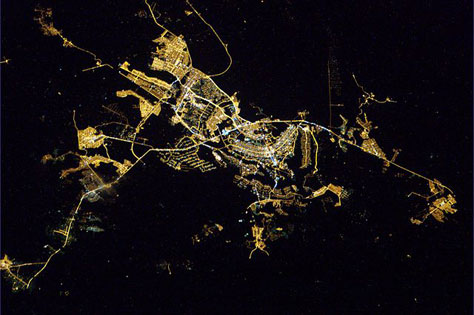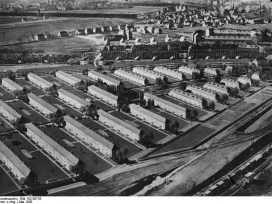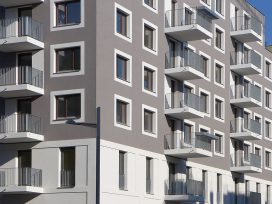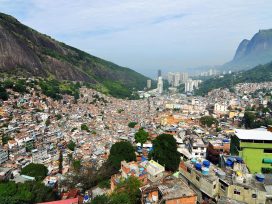For distant admirers of Oscar Niemeyer, Lucio Costa and their crowning achievement of Brasilia, first contact with Brazil’s cities can come as a shock.
The contemporary metropoles in what was once a leader of modernist planning and architecture are chaotic, insalubrious, poorly planned sprawls whose geographies reflect and entrench one of the world’s most unequal distributions of income and incubate often horrific levels of urban violence.

Brasilia, Brazil, by night as seen from the International Space Station. Photo: NASA/Paolo Nespoli. Source:Wikimedia
To a certain extent Brazil must be forgiven its atrocious record of urban planning. Among the European colonizers of the Americas, the Portuguese were the most inept at city-building. In the twentieth century, attempts to overcome such an inauspicious heritage were overwhelmed by one of the most brutal processes of urbanization in human history. In 1920, just 17 per cent of Brazilians lived in towns with more than 20,000 inhabitants. Less than a century later, the figure is 80 per cent. In 1872, the population of the city of São Paulo was 31,385, at a time when the population of Dublin – city and county – was already over 400,000. By 2010 it had transformed itself into one of the world’s largest urban centres, with twenty million people living in its greater metropolitan region, over three times the population of Ireland. It is a shock to see photos from the 1940s of bucolic scenes taken in what are now densely occupied central districts of the city. This pattern has been repeated across the country. Any urban planner would have been stretched to cope with such rapid growth.
Brasilia’s plano piloto and several neighbourhoods in other cities, most importantly São Paulo and Rio de Janeiro, are reminders of the triumphs of the tropical modernist movement that flourished in the country during the middle decades of the last century. But they have since been swamped by subsequent development, almost none of it displaying the same attention to design. These neighbourhoods serve as a kind of monument to a faded moment that held out hope a better urban future for Brazilians, now mocked by the chaos they find themselves imprisoned in. This chaos is the result of varying forms of failure. It is the failure of planning, the accumulated inability over decades to build the necessary infrastructure to meet the needs of swelling urban populations. It is the failure represented by the country’s favelas, the best thing millions of rural Brazilians could manage to build on arrival in the city where they still found themselves under the lash of the country’s cruel regime of social injustices.
But perhaps the most curious failure is that of wealthier Brazilians to maintain the mid-twentieth century modernist tradition. To walk around the São Paulo neighbourhood of Higienópolis is to experience the glory of Brazilian modernism, with its stock of stunning apartment blocks built to the designs of architects working between the 1940s and the 1960s. The neighbourhood features prominently in architectural encyclopaedias. But its fame rests on just several decades of work.
Thereafter it witnessed a decline in design quality, new buildings reflecting trends elsewhere in the country’s cities. From the 1970s, Brazil’s elite and middle class abandoned modernism in favour of pastiches of imported traditional designs. To illustrate lectures on his home city, architect Marcio Kogan shows a series of slides that capture some of the resulting visual chaos. This mishmash includes luxury buildings in an ostentatious neo-classical style replete with ionic columns and Roman arches; neo-French apartment blocks of twenty stories seeking to replicate Haussmann’s Paris complete with small chambre de bonne windows; and soaring neo-Mediterranean blocks whose small curved windows attempt to conjure up the image of a traditional Greek hill village. And then there are the more exotic cases, such as what Kogan terms “Egyptian-French fusion” in which neo-French buildings are given a Pharaonic flourish and “neo-Zumbi” buildings, sporting a African tribal motif.
For heirs to Brazil’s modernist tradition such as Kogan, this turn in design represents a cultural disaster. Like many in his profession he notes that the reasons for it are complex and varied but identifies an inflexion point – the military coup of 1964. In the decades before which, Brazil experienced a period of political and social upheaval that was nevertheless marked by rapid economic growth and burgeoning national self-confidence, reflected in the “Fifty years progress in five” campaign slogan of Juscelino Kubitschek, who as president would oversee the creation of Brasilia. The new capital was the ultimate expression of the self-confidence that coursed through Brazilian architecture. It was Kubitschek who in 1940 helped Niemeyer make his name when as mayor of Belo Horizonte he put the young architect in charge of building an early Brazilian modernist gem, the neighbourhood of Pampulha. The work of many architects for the private sector at this time reflected this self-belief. In modernism they found a new language that allowed them to leave behind the colonial and French styles that until then dominated Brazilian architecture. Importantly, their customers – admittedly mostly well off – shared their confidence, no doubt in part because of the attention Brazilian design was receiving abroad.
Though it manifested a strongly “developmentalist” mentality, the military regime was suspicious of modernism, which it associated with communism. Like Niemeyer, many of the country’s architects were members of the Partido Comunista Brasileiro, or if not, clearly progressive in their political views. That made them targets for the generals. In 1965 Niemeyer quit the University of Brasilia along with two hundred other academics in protest at military interference in university life. In 1966, the regime rejected his plans for the new airport in Brasilia, instead choosing a grossly inferior but ideologically sound project. Unable to work in Brazil, Niemeyer left the next year for Europe and exile.
Dozens of other leading architects were purged from academia, forced into exile or denied public commissions. João Batista Vilanova Artigas, responsible for perhaps Higienópolis’s best loved building – Edificio Louveira – was expelled from the renowned architecture and urbanism faculty at the University of São Paulo which he had helped set up. He fled to Uruguay. Another to suffer was Paulo Mendes da Rocha, one of the masters of São Paulo’s brutalist school, denied work for over a decade after being purged by the regime in 1968. The Italian-born architect Lina Bo Bardi saw her masterpiece the Museu de Arte de São Paulo inaugurated in 1968 and quickly become the iconic symbol of the country’s biggest city. But because of her left-wing views she was marginalized until the military began to loosen its grip in the late 1970s.
The dictatorship’s impact on what can be seen in retrospect as a golden generation was devastating, but it was arguably even worse on the one that followed. As students, they were denied the best mentors and teachers and came of age in an atmosphere of fear and repression. Turning twenty in the year of the coup, the Brazilian photographer Sebastião Salgado, in his recent memoir, writes of his time in exile in Paris. He and his wife fled in 1969 when political repression approached a peak. Having come of age surrounded by the confidence of the bossa nova years that preceded the coup, he joined a community that despite its political defeat back home displayed a certain confidence and cosmopolitanism in exile. “It was in France that we discovered the significance of the word solidarity.” For the Rio de Janeiro architect Paulo Jacobsen such a passage is striking. Born ten years after Salgado, he came of age during the dictatorship. Qualified as an architect but unable to find work, he moved to London in 1982. There he found a younger Brazilian community of exiles from his own generation. But instead of solidarity Jacobsen found isolation. “It is just ten years difference but you can see what happened to Brazil intellectually. Cinema banned, theatre banned, exhibitions banned. It was dangerous. There was fear.” The bravura of Salgado’s generation had been intimidated.
Under the military, the architect in Brazil was stripped of the prestige it enjoyed in the decades before the coup. In the intellectual decadence that the country suffered after the generals took power, it was builders and not architects who dictated design; and with it came the vogue for pastiche styles listed by Kogan. What many of these buildings did was use a false sense of luxury – the soaring Romanesque entrances and Haussmanian flourishes – to mask an underlying cheapness. The sense of pride in delivering quality projects that infused the modernist generation – architects, builders and buyers – had been replaced by the crude hunt for profit among builders.
But what of buyers? Undoubtedly the coup and the intellectual repression that came with it marked the end of the mid-century’s self-confidence. In part they bought what was available on the market. But there was also something of a reaction. By the middle of the 1960s, Brazilian modernism, especially that of São Paulo, had become very radical. Just as they were being purged by the dictatorship, architects were imposing challenging concepts on clients. This produced a rich architectural heritage. But many people who would live in these designs complained of a certain coldness. Hugely interesting projects often made uncomfortable homes. “The children of the families that lived in these houses developed an aversion to modernist architecture. Twenty years ago you often heard people saying they would never live in a modernist home because their parents had lived in one”, says Arthur Casas, another of the leading heirs to the city’s modernist traditions.
One of the most successful architects of imported designs into Brazil is Adolpho Lindenberg, whose role is to be a bogeyman among the São Paulo’s architects. This, thanks to his success with neo-Mediterranean, neo-classical and neo-French projects, along with a conservative political outlook that runs against the pervasive progressivism within the Brazilian architectural community. By running through several cycles of design with little in common other than their essentially pastiche nature, Lindenberg shows an innate understanding of Brazilian society: consumer-orientated, variable, adaptable and, fittingly for the pais do futuro (“country of the future”), obsessed with new trends. He puts his success down to little more than responding to public tastes: “Modernism is most successful in public buildings but people still prefer traditional designs for their homes. It confers a certain status. But modernism is not interested in the personal preferences of the family. It is half-socialist, wanting to teach people how they should live.”
Lindenberg’s criticism highlights a reality that modernism in Brazil was something of an elite project which took place under the wing of the state during a period when for all its Brazilian strains of fascism, nationalism and populism, there was a progressive, developmental energy animating the country’s public life. When the military broke the grip of that era’s architects on Brazilian cities, these were left to the mercies of profit-driven builders and the shifting, often dubious tastes of a public too often obsessed with novelty. The country’s best architects were unable to do more than helplessly look on, often from exile.
But why has the return of civilian rule in 1985 not been marked by another phase of urban inflexion? In part, because the dictatorship ran down the country’s design capacity for political reasons. This problem was aggravated by the economic crisis which took hold in Brazil in the early 1980s and which would last two decades. A country that cannot afford to build much has little need for planning until it eventually loses the capacity for it. The dictatorship’s campaign against architects is unprecedented in Brazilian history. But its other crimes against the urban space – its munificence toward the vested interests of the construction and automobile sectors – are not. This pre- and postdates the dictatorship and extends right up to the current leftwing administration of the Workers Party. The auto sector remains the backbone of Brazilian industry and governments have historically done its bidding. This has resulted in decades of public policy that has prioritized car ownership and road-building over expanding the rickety, overloaded public transport network. The Workers Party’s first president, Luiz Inácio Lula da Silva, turned car ownership into something of a fetish during his time in power, exulting in ever higher rates ownership even as this further clogged up his country’s cities. Brazil still seems to be in thrall to Le Corbusier – who put the car at the centre of his urban vision and who was a huge influence on Niemeyer – when much of the rest of the world has turned critical.
This precedence of private over public is also reflected in land use. Despite the Brazilian constitution of 1988 stating that the right to private property is subordinate to its social function, and the right to housing absolute, Brazil’s courts today treat private property as absolute and the right to housing as being subordinate to it. Thus, Brazilian cities are home to tens of millions of people living in favelas, while undeveloped land or abandoned buildings remain unused but subject to intense property speculation. After the return of democracy, Brazil passed a city statute that sought to give meaning to the constitution’s demand that urban development play a social role. But it has singularly failed to weaken the grip of big business over the country’s cities.
The Workers Party has sought to provide more social housing, but unfortunately the historical care for the interests of builders seems to have been paramount in the elaboration of its massive housing programme Minha Casa Minha Vida (“My house my life”). This sees poorer Brazilians receive subsidized loans from state banks to buy houses contracted by the government from construction companies. The latter are paid for the quantity of units they deliver rather than the quality of each project. This has resulted in the building of endless rows of small, cheap houses on cheap land distant from urban centres with little social infrastructure or transport links to distant jobs. Amazingly this model replicates previously failed housing programmes such as Cidade Tiradentes in São Paulo and Cidade de Deus in Rio on a national level. It also acts as a form of slum clearance, with residents of favelas removed from sites that have become prime urban real estate and relocated to the desolate periphery. In a culture that favours the car over public transport, this acts as a form of social exclusion. Architectural practices noted for their social housing projects are excluded from the programme as builders contract the cheapest design teams possible in the push to maximize profit while government expects an electoral return, with over three million houses to be built or on order by the end of 2014, an election year in which construction groups will be, along with banks, the biggest contributors to Brazilian political campaigns.
Whether the Brazilians who have taken out the loans to pay for these houses will be willing to keep up their payments when – as critics warn – these new neighbourhoods reveal their grave planning flaws remains to be seen. But they already stand as sad additions to Brazil’s already scarred urban landscape. Pockets of intelligent public works such as the high-density, centrally located and well integrated Jardim Edite social housing project in São Paulo are notable for their rarity.
A hint of the problems quality work would face under democracy was provided when three young architects won the first major public competition since the return of democracy to design Brazil’s pavilion at the Seville Expo in 1992. But the government of president Fernando Collor – later impeached – cancelled the project, alleging a lack of funds, even while his political machine was illicitly bankrolled by, among others, large construction companies. But another grave impediment to quality public work is the result of an honourable intention that passed into law in 1993 after the return of democracy. Federal law 8.666 demands that all public spending be put out to tender, with the lowest bidder declared the winner. The intention was to combat corruption. Instead, evidence has accumulated pointing to a range of underhand tactics, from cartels of companies rigging auctions through overbilling to the loophole of contract additives, raising serious questions as to how effective the law has been. But for design quality, 8.666 has been a disaster: architectural services are contracted on the same basis on which the state buys toilet seats – by auction, with the cheapest bid declared the winner. The law gives no weight to architecture’s cultural or social function in society. Its very existence means that many of the country’s best architectural practices avoid bidding for public works projects. Why invest the resources when you know the process is rigged to favour of the cheapest – and so, typically, the shoddiest – project? The law has led to the banalization of Brazilian architecture and demoralized its practitioners. It goes a long way towards explaining the uninspiring design of public works in Brazil in recent decades.
The problem with Law 8.666 is recognized. When São Paulo came to build a new cultural centre as part of an effort to rejuvenate its downtown it completed the time-consuming, bureaucratic but necessary procedures that allowed it to suspend the law in favour of a more nuanced process that recognized the true value of design when choosing a project. The result is the much-lauded Praça das Artes complex of local practice Brasil Arquitetura, which stands as an example of the creative forces waiting to be unleashed by a revision of 8.666.
How likely such a change is cannot be gauged. But even if it were to occur, on its own it would do little to break the grip vested interests have on Brazilian cities. And yet current public tastes are crying out for better design. In the private housing market pastiche is out, contemporary modernism in, especially among younger and first-time buyers, prompting construction companies to seek out the architects able to meet this new demand. But perhaps the most significant development was the sudden outbreak of huge demonstrations across the country last year. These started as a protest against a small hike in bus fares in São Paulo but quickly spread nationwide. Soon the hundreds of thousands on the streets in dozens of large cities had produced a much larger, though inchoate, set of demands. But a central theme was disgust at the dismal quality of urban life in Brazil, especially transport – the original spark – education and health, and the belief that political corruption was responsible. Personal consumption has increased since the millennium, broadening the horizons of tens of millions of the country’s citizens. But their cities have not kept pace. Despite politicians having so far sidestepped demands for political reform, the central role of the city in most Brazilians’ lives has been forced up the agenda.
Politicians must thus regard the preparations for the World Cup as a missed opportunity. Though much was promised especially in urban transport little has been delivered. The contrast with the new hugely expensive stadia readied for FIFA filled protesters with anger, incredibly turning the World Cup itself into a target in the pais do futebol. Preparations for the tournament and the Olympics in Rio have accelerated the dynamics of property speculation in Brazilian cities and facilitated the transfer of public space into private hands with no obligation that what has been privatized fulfil a social function independent of market forces. In this regard the World Cup has utterly failed to be the promised game-changer for Brazil. The recent protests mean what comes next for the country’s cities is not a given, despite the strength of the special interests that have historically dominated their destinies. But if they are to become more fulfilling urban experiences then those who took to the streets last year need to become more fully engaged citizens in the battle to transform them.







